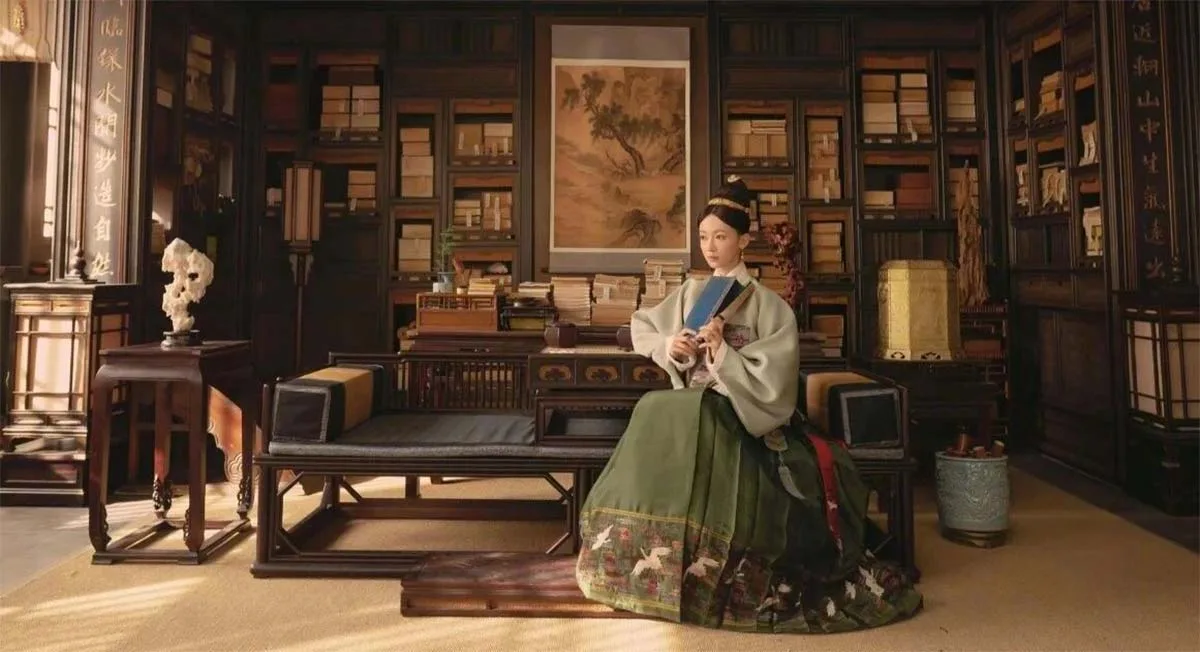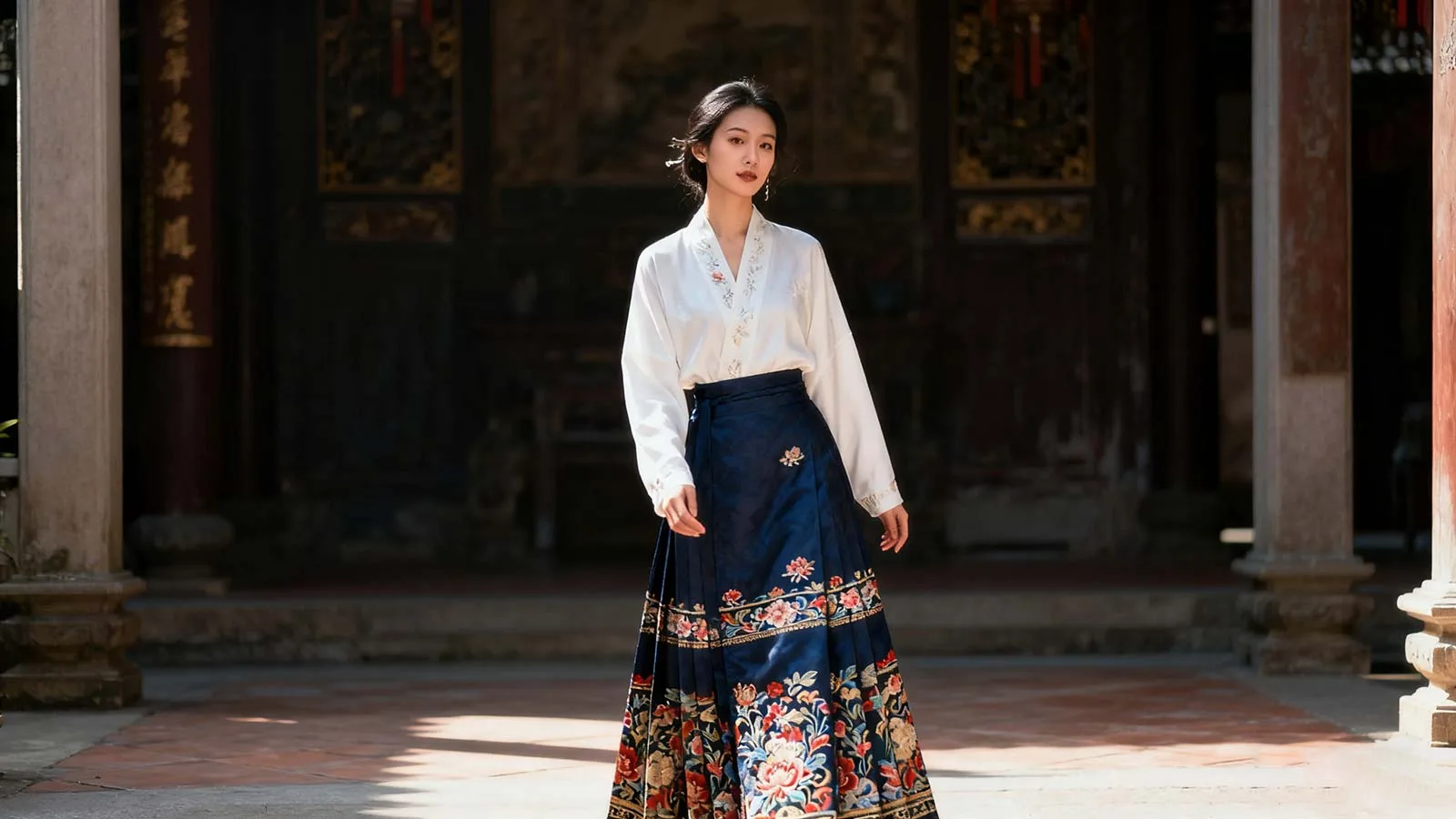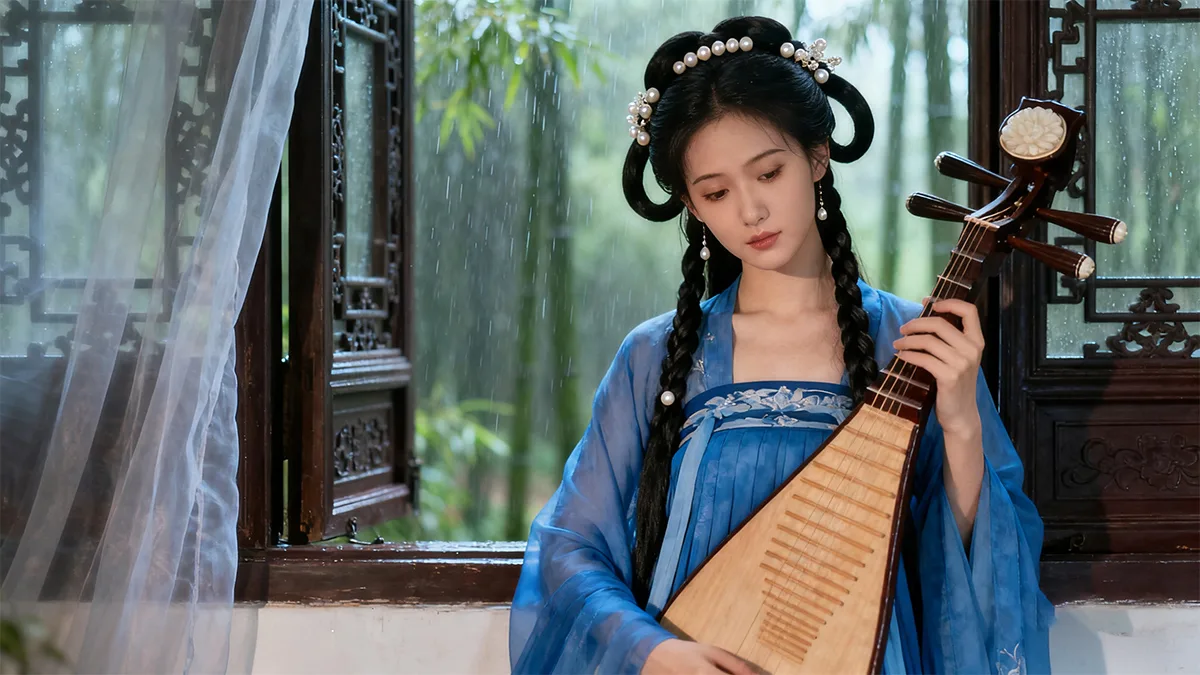What was the typical attire for women in the Ming Dynasty? Excluding ceremonial occasions that required formal outerwear such as round-collared robes (圆领袍) or large ceremonial jackets (大衫), the most common clothing style for women was very clear: a jacket (袄衫) on top and a skirt on the bottom, known as a “two-piece outfit” (两截穿衣).
The skirt in this ensemble is what has become popular nationwide this year as the “Mamian Skirt” (Horse-Face Skirt)—a name derived from its appearance. The term “horse-face” originally referred to a protruding tower on city walls, whose front resembled the face of a horse. The Mamian Skirt has gained widespread popularity for two main reasons: it pairs easily with modern clothing, and it allows for freedom of movement—this was also its original purpose when it was created. Today, many Hanfu brands produce Mamian Skirts, but to truly go beyond mere resemblance, one must understand and master the design language of Ming dynasty Mamian Skirts.
The Mamian Skirt paired with a jacket (袄衫) formed the typical two-piece outfit for women.
In Ming vernacular, women were often referred to with the phrase “three-braid hairstyle, two-piece clothing” (三绺梳头、两截穿衣). For example, in Chapter 32 of Awakening the World to Marriage (醒世姻缘传), it says:
“Even those of us in lofty official attire would not perform such acts, yet a woman with three-braid hair and two-piece clothing did, making the men redundant.”
The two-piece outfit had been the basic casual attire for women since the Tang and Song dynasties and remained the typical combination for Ming women. However, both the skirt and the jacket differed from those of previous generations. The skirt in this ensemble is what has recently become widely popular nationwide as the “Mamian Skirt” (Horse-Face Skirt)—a name given later based on its appearance. The Mamian Skirt gained popularity for two main reasons: it pairs easily with modern clothing, and it allows freedom of movement—this was also its original purpose when it was created.
The ancestor of the Mamian Skirt was the Song Dynasty “Xuan Skirt” (旋裙). According to clothing researcher Meng Hui, the Northern Song text Jianglin Ji Zazhi records:
“Women, not wearing wide trousers or cupped skirts, made Xuan Skirts, which must open at the front and back for riding donkeys.”
Meng Hui explains that since the Han Dynasty, traditional women’s skirts had always been single-piece skirts (片裙). The innovation of the Xuan Skirt was that it consisted of two overlapping panels sewn to the waistband, creating front and back slits—one visible, one hidden. This design prevented the skirt from bunching on the saddle when riding, as the slits allowed the fabric to fall naturally over both legs. This was the prototype of the Mamian Skirt.
The term “horse-face” (马面) originally referred to a protruding tower on city walls, whose front resembled the face of a horse. The first recorded use of “horse-face” to describe clothing appeared in a Ming text describing the construction of a long robe called Yesa (曳撒). By the Ming Dynasty, the Mamian Skirt evolved from the Xuan Skirt by adding pleats along the sides of the overlapping panels. This not only increased mobility but also enhanced its visual appeal. As a result, the skirt resembled the lower part of the Yesa robe, with a rectangular “horse-face” formed at the overlapping center and pleats on both sides.
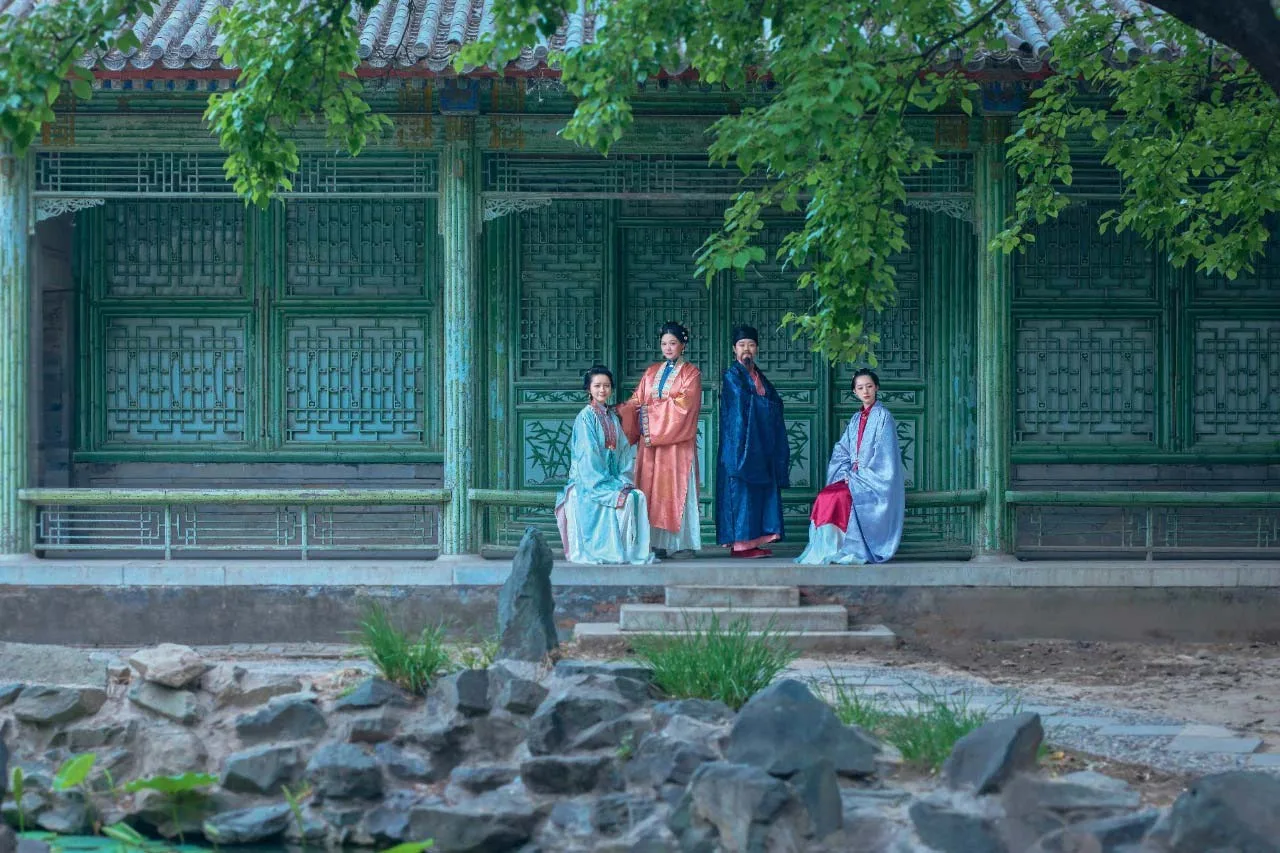
Today, many Hanfu brands produce Mamian Skirts, but truly mastering the design language of Ming Dynasty Mamian Skirts goes far beyond simply copying their appearance. One key detail is how the pleats are made. Professor Jiang Yuqiu from Beijing Institute of Fashion Technology once restored a Mamian Skirt unearthed from the Li Jiafen Ming tomb in Wangdian Town, Jiaxing, Zhejiang. “The skirt was very damaged,” she recalls. “Looking at the creases, some folded inward, some outward. I used origami techniques to study and replicate them.”
During her research, she discovered that at the center of each pleat group on both sides of the skirt, there was a special design called the “Hebaopleat” (合抱褶). “What does this design do?” she explains. “When the opposing pleats on either side apply pressure inward, the Hebaopleat pushes pressure outward, balancing the forces. This creates a natural sense of space in the skirt.” Jiang later found Hebaopleats present in many other Ming-era Mamian Skirts, showing the remarkable sophistication of ancient designers—a detail often overlooked by modern reproductions.
The decoration of Mamian Skirts also followed specific rules. Dong Jin, author of Q-Version Illustrated Compendium of Ming Costume, notes that many contemporary brands, aiming for a luxurious look, tend to cover the entire skirt with patterns. “In fact,” he explains, “the decorations on Ming Mamian Skirts were primarily located on the knee panels and the bottom panels. In the early Ming, when jackets were shorter, the knee panels were decorated. By the late Ming, jackets became longer, so the skirt’s bottom panels were embellished, as only the lower edge of the skirt would be visible.”
Dong continues, “If both the knee panels and bottom panels are decorated, the proportions matter. A wider knee panel with a narrower bottom panel suggests the jacket should be short. Conversely, a narrower knee panel with a wider bottom panel shifts the visual focus downward, meaning the skirt should be paired with a longer jacket. From the decoration alone, one can infer the correct upper garment to wear with the skirt.”
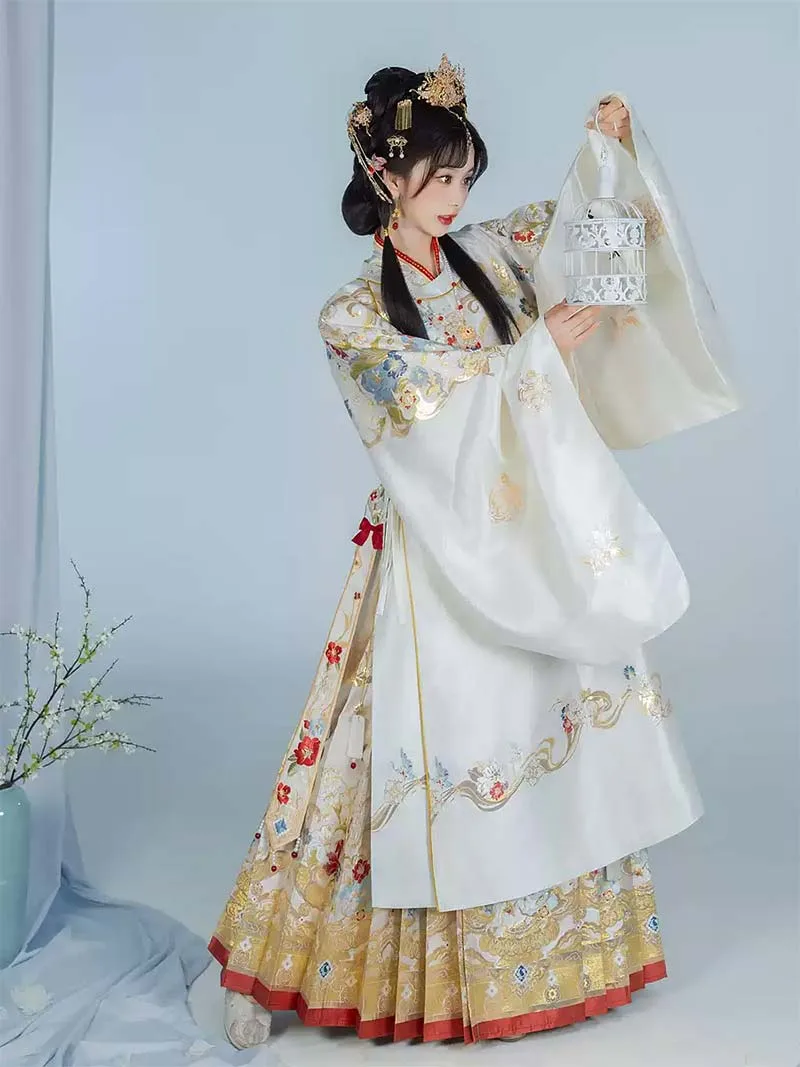
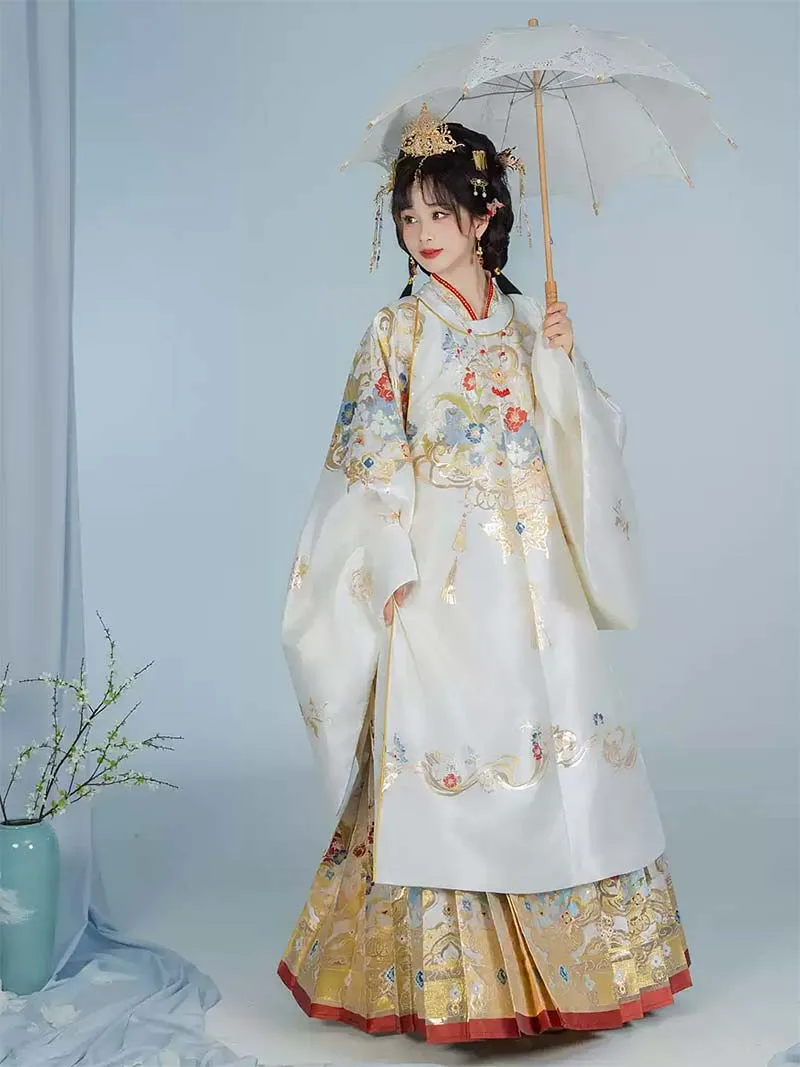
The Confucius family of Shandong’s Yansheng Gong left behind an extraordinary collection of clothing, including over 100 garments from the Ming Dynasty—making it the largest surviving set of Ming-era apparel in existence. Among these treasures, a vibrant celadon-green Mamian Skirt with embroidered dragons stands out as particularly significant. The skirt features the five-clawed mang dragon motif, a symbol of high imperial rank, indicating that it was likely a gift from the emperor. Its craftsmanship combines intricate embroidery with gold weaving, exuding an unmistakable sense of luxury.
The celadon-green hue closely matches the Mamian Skirts worn by women depicted in the Ming Xianzong Lantern Festival Painting, suggesting it was a popular color at the time. Today, Hanfu brands frequently recreate this skirt, and its dragon motif has made the replica a sought-after item during Chinese New Year celebrations, especially in the Year of the Dragon. The skirt itself features two panels that taper from a narrow top to a wider bottom, a detail that influences how it should be styled.
Dong Jin, a noted historian of Ming clothing, explains that some catalogues in the past paired this skirt with another Confucius family piece—a dark green short jacket adorned with phoenix motifs. However, the skirt’s wider bottom panel indicates that it should be worn with a longer jacket, and given the grandeur of the dragon embroidery, the correct match would be a round-collar robe.
In 2020, during the exhibition “Mastering the Garments: Ming Dynasty Costume Culture” at the Shandong Museum, Professor Chu Yan from Beijing Institute of Fashion Technology collaborated with the museum to reproduce three garments from the Confucius collection. This effort not only allowed in-depth study of their construction but also provided replicas suitable for future exhibits. One of the reproduced pieces was a white Mamian Skirt with subtle floral and bird embroidery. Unlike the imperial dragon skirt, this garment was considered casual wear, yet Professor Chu holds a particular affection for it.
“Many Mamian Skirts feature repeating patterns,” she explains, “but this one is more like a painting, with each embroidered element unique.” As a fashion design educator and founder of her own “New Chinese” clothing brand, Chu finds that the thoughtful layout of these patterns provides valuable inspiration for contemporary Chinese fashion design.
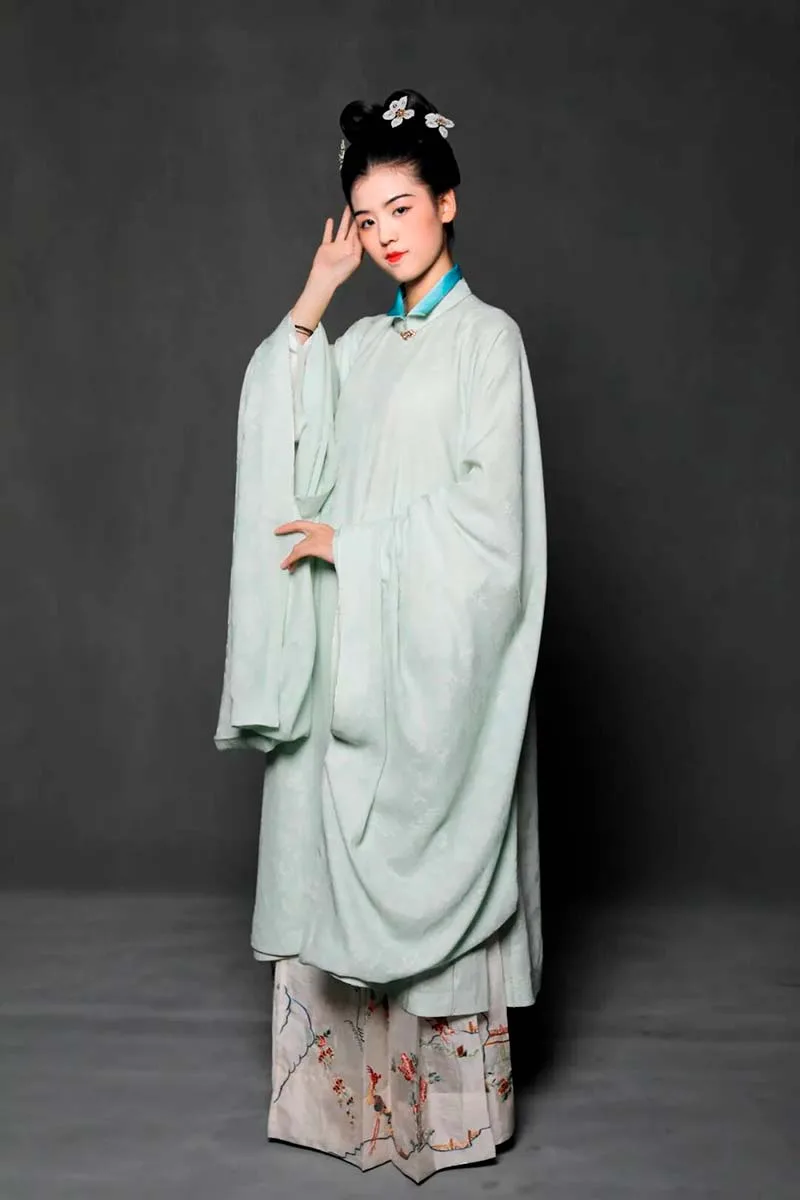
Professor Chu Yan showed me the reproduced Mamian Skirt, whose decorations are entirely concentrated on the bottom panel. The embroidery features a rich array of motifs, including mountains, small bridges over flowing streams, peonies, pomegranate flowers, water lilies, hollyhocks, morning glories, bamboo, butterflies, kingfishers, and phoenixes.
“The real challenge in reproducing this skirt,” Chu explains, “is that many of these embroidered motifs are hidden within the pleats—you have to carefully unfold them to see the full design.” The embroidery is done in Lu embroidery, a traditional style from Shandong, known for its slightly thicker silk threads, giving the work a distinctive northern robustness. Even motifs that appear to be similar in color actually use subtly different shades of thread. Chu counted and found that over 30 different colors were used in this single skirt. Recreating it took four skilled embroiderers two full months—a testament to the meticulous attention to detail in aristocratic casual wear of the Ming era.
Another distinctive feature of Ming women’s clothing is the vertical collar jacket worn over the Mamian Skirt. Starting in the mid-Ming period, in addition to the traditional round and cross collars, vertical collars became a popular style for women. These jackets could have a high placket or a vertical front overlap. Unlike the later qipao collar, the vertical collar was not meant to fit tightly against the neck, leaving some space for comfort. Over time, this style laid the foundation for the standing collars seen in later traditional Chinese women’s attire. Worn casually, the collar could also be slightly folded down, creating subtle variations in appearance and adding elegance to the overall ensemble.
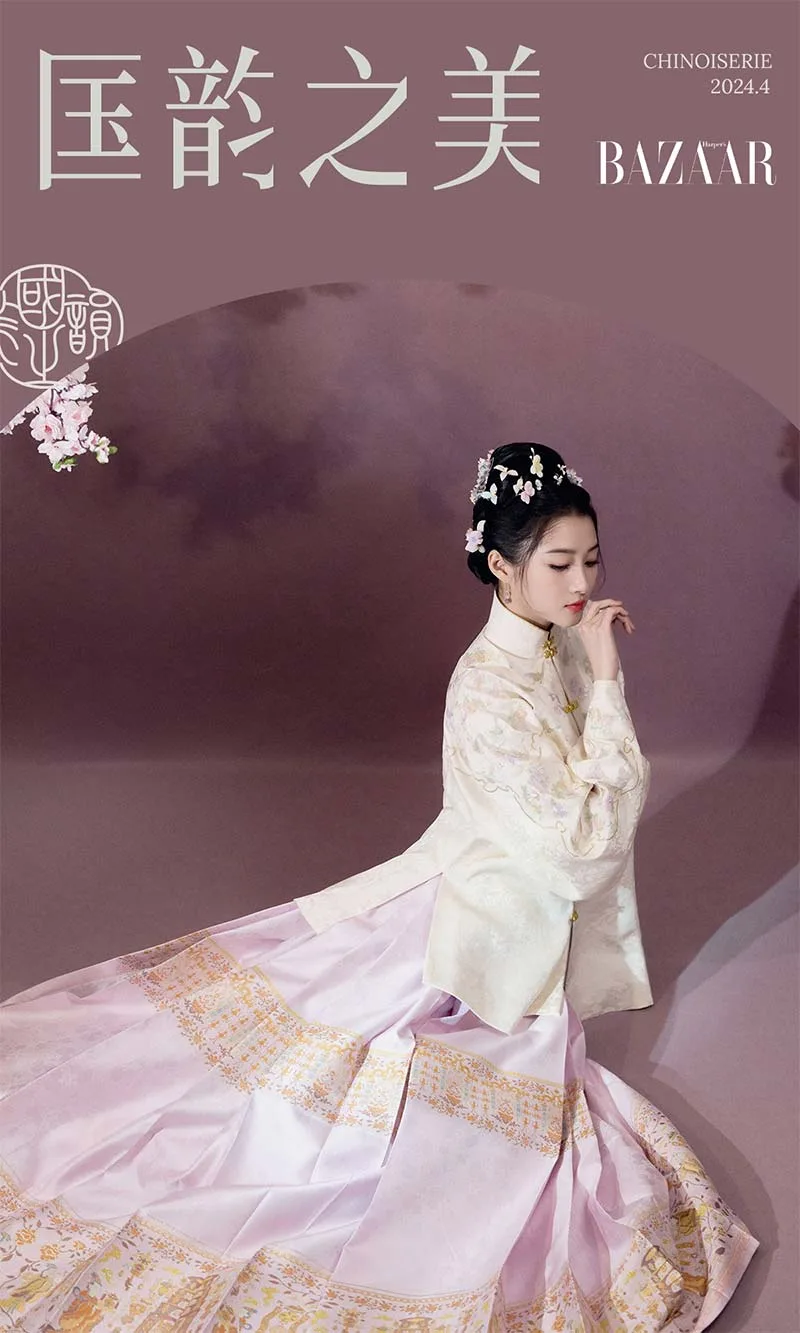
The introduction of the vertical collar also created a platform for a new decorative element: buttons. According to fashion historian Meng Hui, frequent trade between the Ming Dynasty and Central and West Asia brought a variety of exotic gemstones to China, which were often used in button-making. A single intricate interlocking “mother-and-child” button could be crafted from gold or silver, inlaid with gemstones, and shaped into designs ranging from floral and insect motifs to figures, deities, or auspicious characters. On a vertical-collared jacket, there could be as many as seven of these ornate buttons, allowing noblewomen to display their wealth and status.
But why did vertical collars become popular? Meng Hui offers two explanations. First, the mid-Ming period coincided with a minor ice age, and the higher collars helped keep wearers warm. Second, the rise of Neo-Confucianism (Cheng-Zhu School) imposed strict moral expectations on women, emphasizing chastity and modesty. By the mid-to-late Ming era, these societal norms had been enforced to the point where the female body was highly regulated. Vertical collars, combined with decorative buttons, effectively concealed the neck and chest, reflecting both practical and ideological considerations—allowing the clothing itself to uphold the values of the patriarchal society.
Discover the timeless charm of traditional Chinese fashion with our Mamian Skirt collection. Whether you’re looking for an elegant outfit for special occasions or a stylish piece for daily wear, our curated selection blends historical design with modern comfort, making it easy to incorporate the beauty of Ming Dynasty attire into your wardrobe.
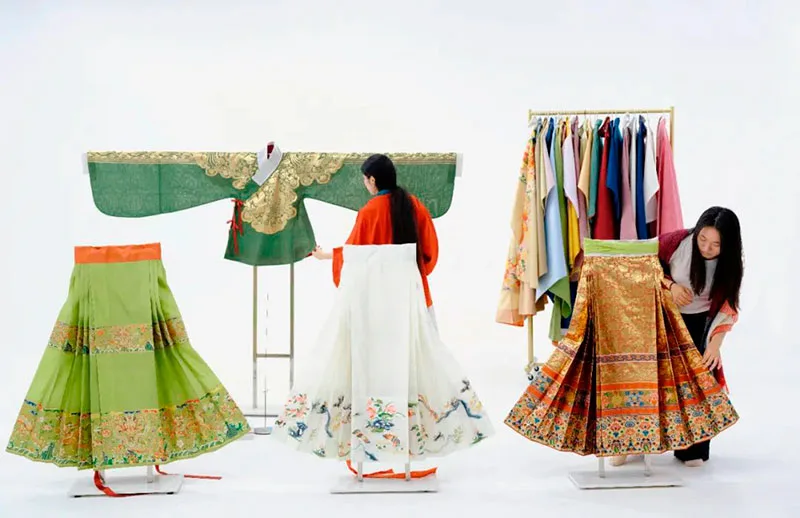
The Dao robe and the yesa: male attire between stillness and movement
In contrast to the elegant combination of a Mamian Skirt and a jacketed top for women, the quintessential male attire of the Ming Dynasty was undoubtedly the Dao robe. As Ming scholar Fan Lian noted in Yunjian Jumu Chao, Volume 2 – Customs: “Men’s clothing… since the reigns of Longqing and Wanli, all wore Dao robes.” In other words, from the mid-to-late Ming period, the Dao robe became standard daily wear for men across social classes, from emperors and officials to common scholars and civilians.
Originally, the Dao robe was the ceremonial garment of Daoist priests, as its name suggests. Costume researchers Xu Xiaopan and Wang Lei explain that after the Yuan Dynasty unified China, the imperial court actively promoted Daoism, increasing the visibility of Daoist rituals in society. The Dao robe, with its loose fit and wide sleeves, exuded the refined elegance admired by the scholar-official class. As it gradually became secularized, its style and structure were firmly established.
A typical Ming Dao robe was cut in a straight, continuous line from top to bottom, featuring a broad cross-collar and often a white or plain protective collar trim. It included a subtle “hidden hem” to conceal side slits, ensuring that undergarments remained discreet. When worn, the robe was commonly paired with silk or cloth sashes around the waist, either thin or wide, completing the look with both practicality and grace.
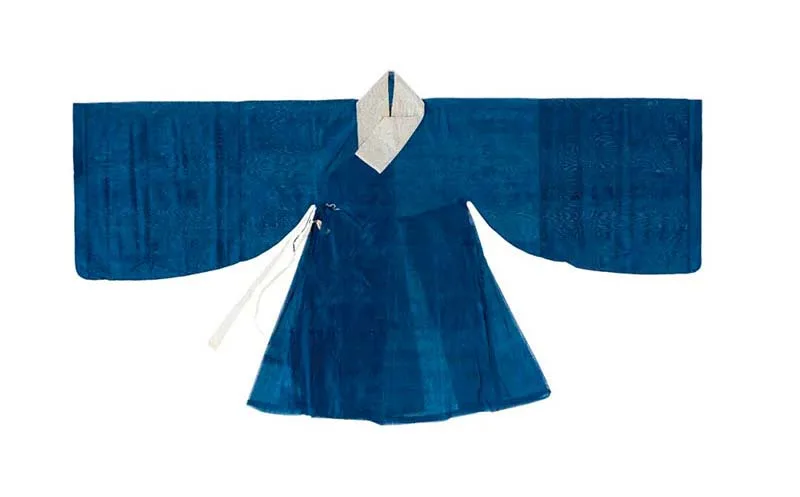
When Chu Yan undertook the replication of male garments from the Kong Family’s historical collection, she chose a dark blue brocaded Dao robe. Dyed with indigo, its subtle pattern isn’t immediately visible in photos, but the robe’s fabric is woven with delicate motifs—cranes clutching lingzhi mushrooms, longevity peaches, pomegranates, and “Four Corners Ruyi” designs. “The style is simple yet timeless,” Chu Yan told me, “at a glance, you can immediately picture a Ming Dynasty scholar.”
Today, the challenge in recreating such a robe isn’t the motifs themselves, but the gauze-like fabric used. Modern looms can produce very fine threads, but it’s actually difficult to replicate the slightly coarse, uneven texture of the handmade threads used in the Ming period. Interestingly, among the Kong Family’s preserved garments, gauze-based fabrics dominate, signaling their prestige and popularity at the time—a lesson that inspires today’s Hanfu designers.
Zhong Yi, founder of Ming Hua Tang, a brand dedicated to Ming-style Hanfu, shared how this historical insight shaped his product design: after seeing the Kong Family exhibition, he realized that gauze fabrics offered structure and body, while silk and satin, though soft, lacked the same sculptural quality. He therefore shifted his focus to gauze for his modern reproductions. “Another advantage of gauze is breathability,” Zhong Yi added. “Historically, people often wore multiple layers underneath. Gauze as the outer layer kept them from overheating.”
Gauze Dao robes frequently appear in Ming-era literature. In Yu Shi Ming Yan (Vol. 1), a Chen-family merchant is described wearing a fish-belly white gauze Dao robe paired with a traditional Su-style hat. Similarly, in Xingshi Yinyuan Zhuan (Chapter 26), a young man of eighteen or nineteen is portrayed in a goose-yellow gauze Dao robe and bright red satin shoes—demonstrating that such robes were both fashionable and emblematic of cultured status.
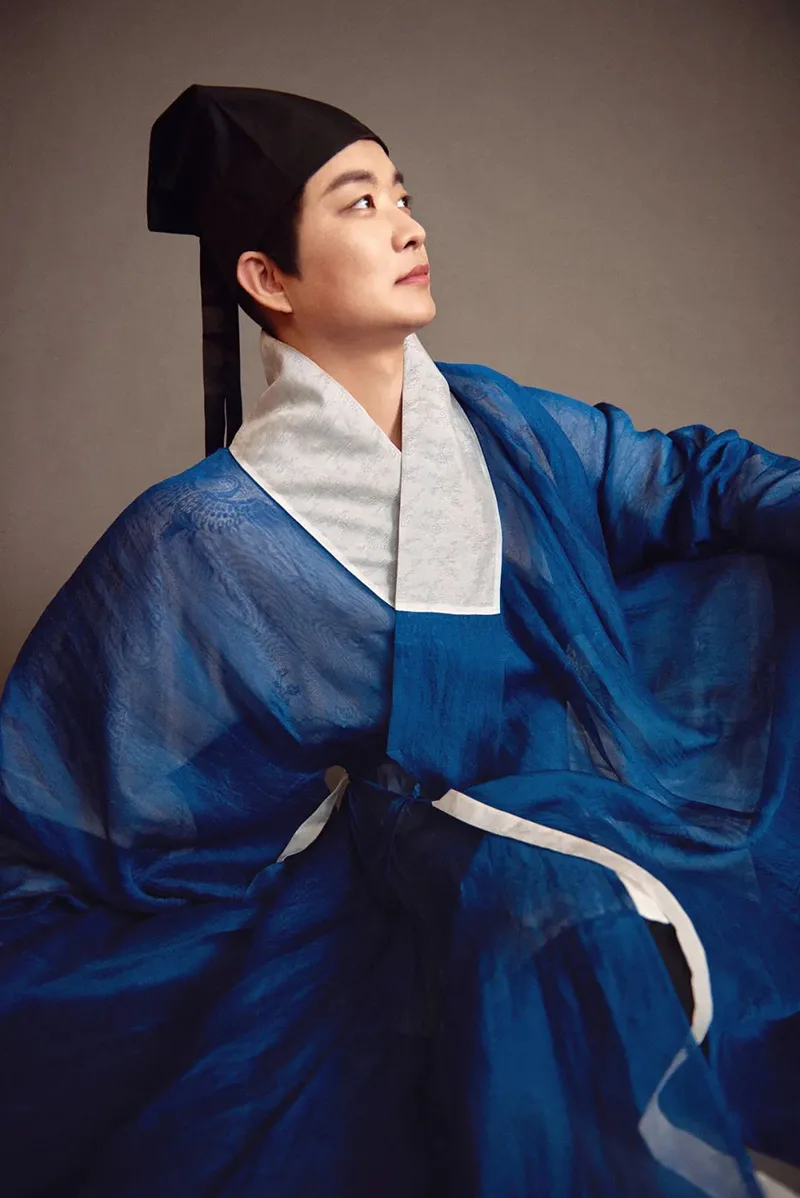
The Colors and Styles of Ming Dao Robes and Male Garments .Dao robes in the Ming Dynasty came in a wide range of colors. Scholar Zhu Zhiyu, in his work Zhu Shi Shun Shui Tan Qi, notes the primary shades for Dao clothing as: moon white, emerald blue, sky blue, ivory, pine green, soy sauce brown, cashmere color, and scallion white—all eight were considered acceptable. Early in the reign of Emperor Wanli, Minister of Rites Lu Shusheng commissioned a series of portraits depicting himself in different outfits, preserved as the Album of Lu Wending Gong. In one portrait, the elderly Lu is shown wearing a pink Dao robe, exuding an unexpected sense of style. This flexibility in color and design has helped the Dao robe remain a favorite among contemporary male enthusiasts of Ming-style Hanfu.
Beyond the Dao robe, another set of male garments from the Ming era has gained attention today: the Tieli and Yesa robes, both cut in a “broken waist” style. Costume historians Chang Xiaojun and Wang Chuyun trace their origin to the Yuan Dynasty’s braided-line robes. Both styles share features: cross-collars, right-over-left closures, and a garment structure divided into a top and a lower section, with skirt-like pleats at the hem. Yet subtle differences distinguish them: Tieli’s hem is entirely pleated, resembling a pleated skirt, while Yesa features a “horse-face” panel at the center of the hem, echoing the lower portion of a Mamian skirt.
These garments also differed in social use. Tieli were worn across social strata, from nobility to commoners, and could be worn both as outerwear or as an inner layer. As outerwear, Tieli could be lavishly decorated, even with dragon motifs. For scholars and literati, a Tieli often served as an inner garment, its pleated construction providing structured support for outer robes. In contrast, Yesa were typically reserved for nobles, high-ranking officials, or ceremonial purposes, and after the mid-Ming period, also used as military uniforms.
Modern Hanfu enthusiasts’ interest in these garments is closely tied to the Kong Family’s historical collection, particularly the famed “fragrant hemp flying-fish Tieli”, and the replicas created by hobbyists. In 2013, Chen Xuefei, then a member of the Hanfu Beijing community, formed a small group called Kongxian Si, practicing traditional archery together while wearing Hanfu. One day, he came across a photo of the fragrant hemp flying-fish Tieli and was inspired to recreate it, combining his artistic skills with a passion for historical authenticity. This initiative sparked renewed interest among collectors and practitioners in exploring Ming-era male garments beyond the classic Dao robe.
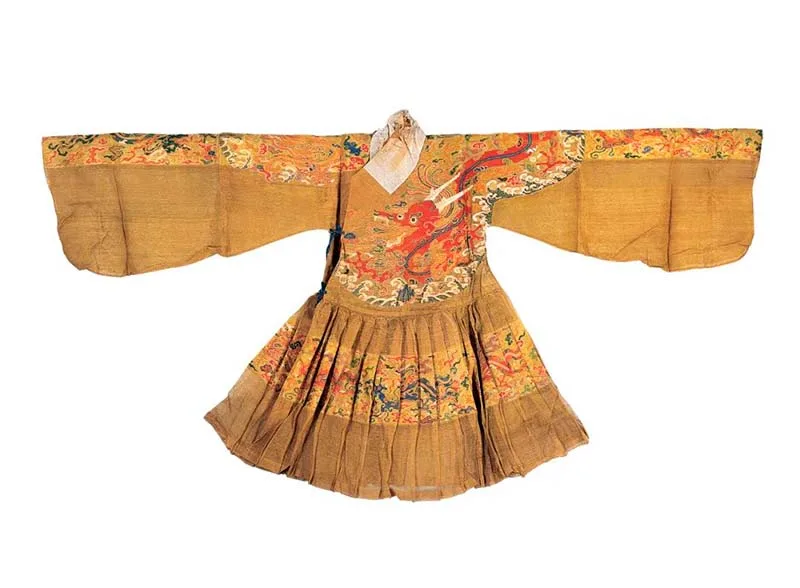
“I gathered every image and reference I could find and spent two months hand-painting the design onto a simple cotton robe,” Chen Xuefei recalls. “Since the garment featured cloud shoulders, wide sleeves, and pleated knee panels, the patterns followed a clear structure. Even the reverse side had symmetrical designs, so we could accurately reconstruct the motifs.”
The finished piece was widely praised within the Hanfu community, and soon Chen created a printed version so that each member of his Kongxian Si group could have one. As interest grew, more Hanfu enthusiasts approached him wanting to buy the same style. This demand eventually led him into commercial production, and he founded Kongxian Si, a brand specializing in Ming-style Hanfu for men. Today, the most popular pieces remain the flying-fish patterned Tieli and Yesa, celebrated for their historical authenticity and striking design.
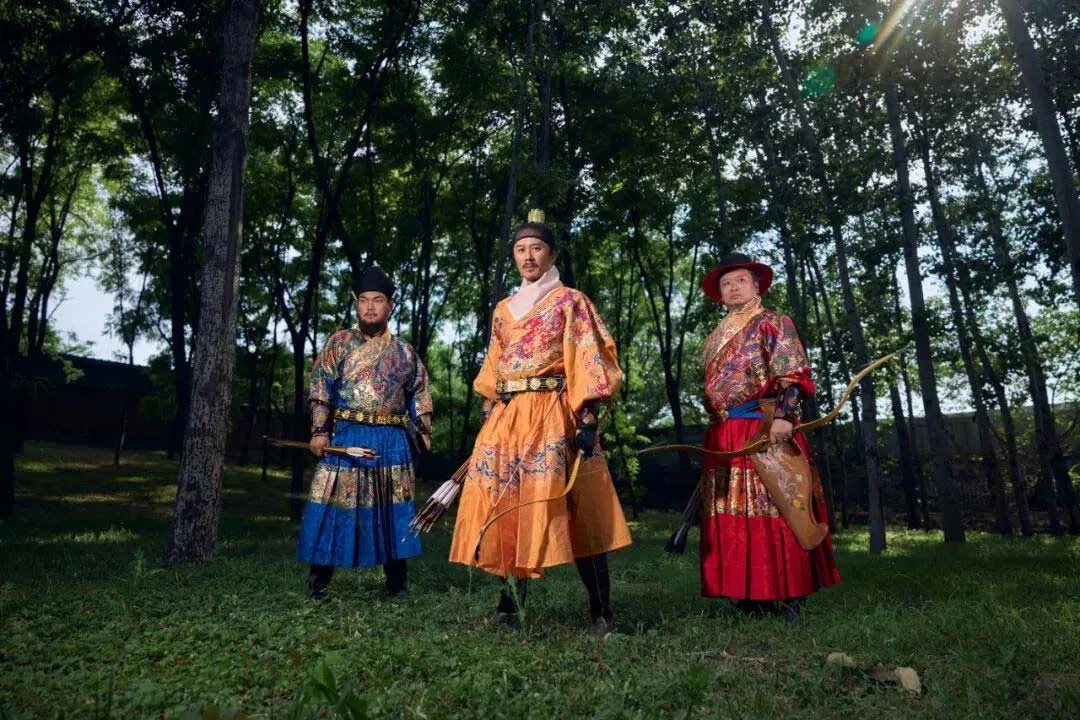
These garments are often referred to by Hanfu enthusiasts as “Flying Fish Robes,” though the name isn’t entirely accurate. Zhou Yu, author of Illustrated History of Chinese Armor, explains: “‘Flying Fish’ is the name of a pattern. It looks somewhat like a dragon but isn’t one—it has a dragon’s head and a fish’s tail. Flying Fish Robes were bestowed garments, a special honor, but they weren’t the only form of granted clothing in the Ming dynasty. In the Ming hierarchy of patterns, the highest-ranked motif was the mang dragon, followed by the flying fish, and then the fighting bull. They all belong to the so-called ‘dragon-like’ designs, which resemble dragons but with distinct differences in detail.”
Zhou adds that the term “Flying Fish Robe” can be used broadly for any garment featuring the flying fish motif—it doesn’t specifically refer to Tieli or Yesa. In popular media, for example, the Jinyiwei are often depicted wearing Tieli or Yesa, but all are loosely called “Flying Fish Robes,” and the patterns on them may vary.
Zhou, who regularly wears Hanfu himself, favors a flying fish Tieli. He explains one practical difference between Tieli and Yesa: the Yesa has small “winged corners” at the sides of its hem, designed to prevent undergarments from showing, which adds elegance but requires more adjustment when worn. Tieli, by contrast, is simpler to wear. Chen Xuefei prefers Yesa, noting that the smooth “horse-face” panel at the hem makes sitting more comfortable.
Both Tieli and Yesa are often described as “activewear of Hanfu” because, compared to wide-sleeved Daopao, they allow much more freedom of movement. Chen wears his Yesa during special festivals for archery or horseback riding, while Zhou showed me a video of himself performing a sword dance in a Tieli, where the hem swirls and flows gracefully, demonstrating both elegance and ease of movement.
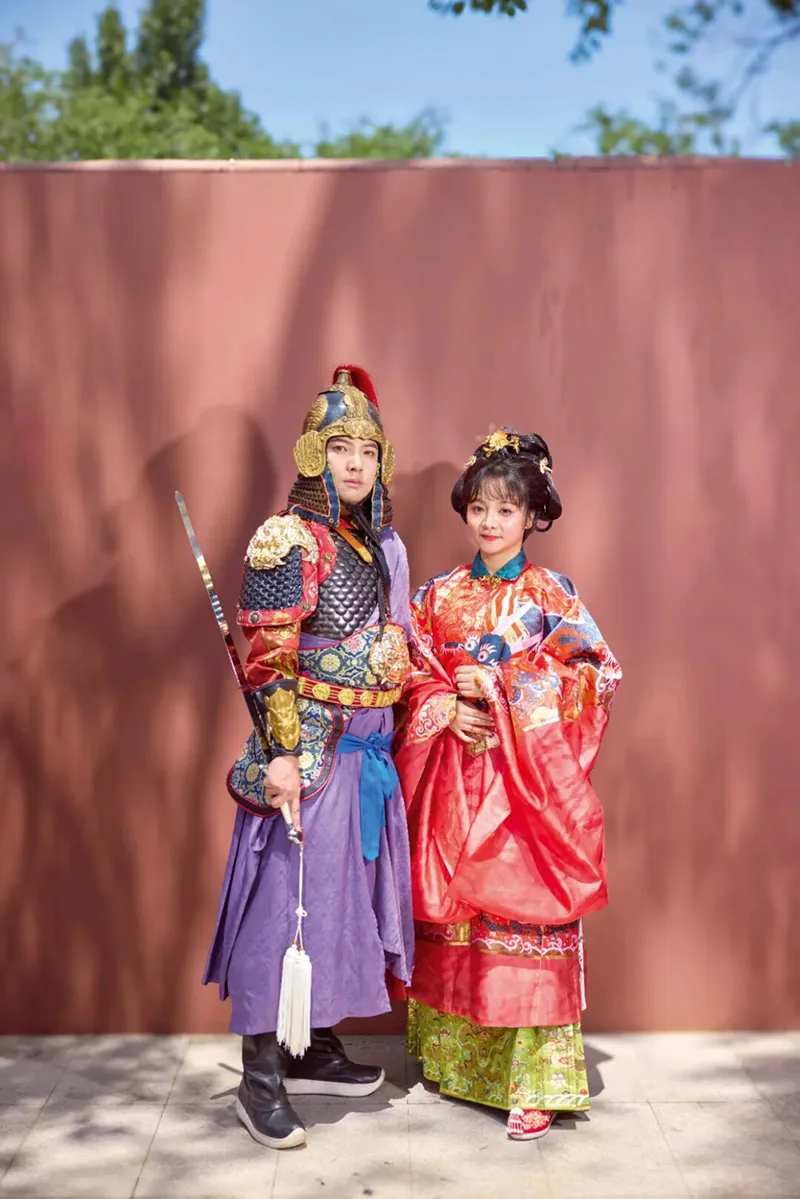
If you’re fascinated by Ming dynasty hanfu menswear, you can explore authentic Ming-Dynasty Hanfu collections online to see Tieli, Yesa, Feiyu, Dao Robe and other classic designs recreated for modern wear. Whether you’re looking for ceremonial outfits or activewear-inspired pieces, these garments let you experience the elegance and craftsmanship of Ming dynasty fashion firsthand.
